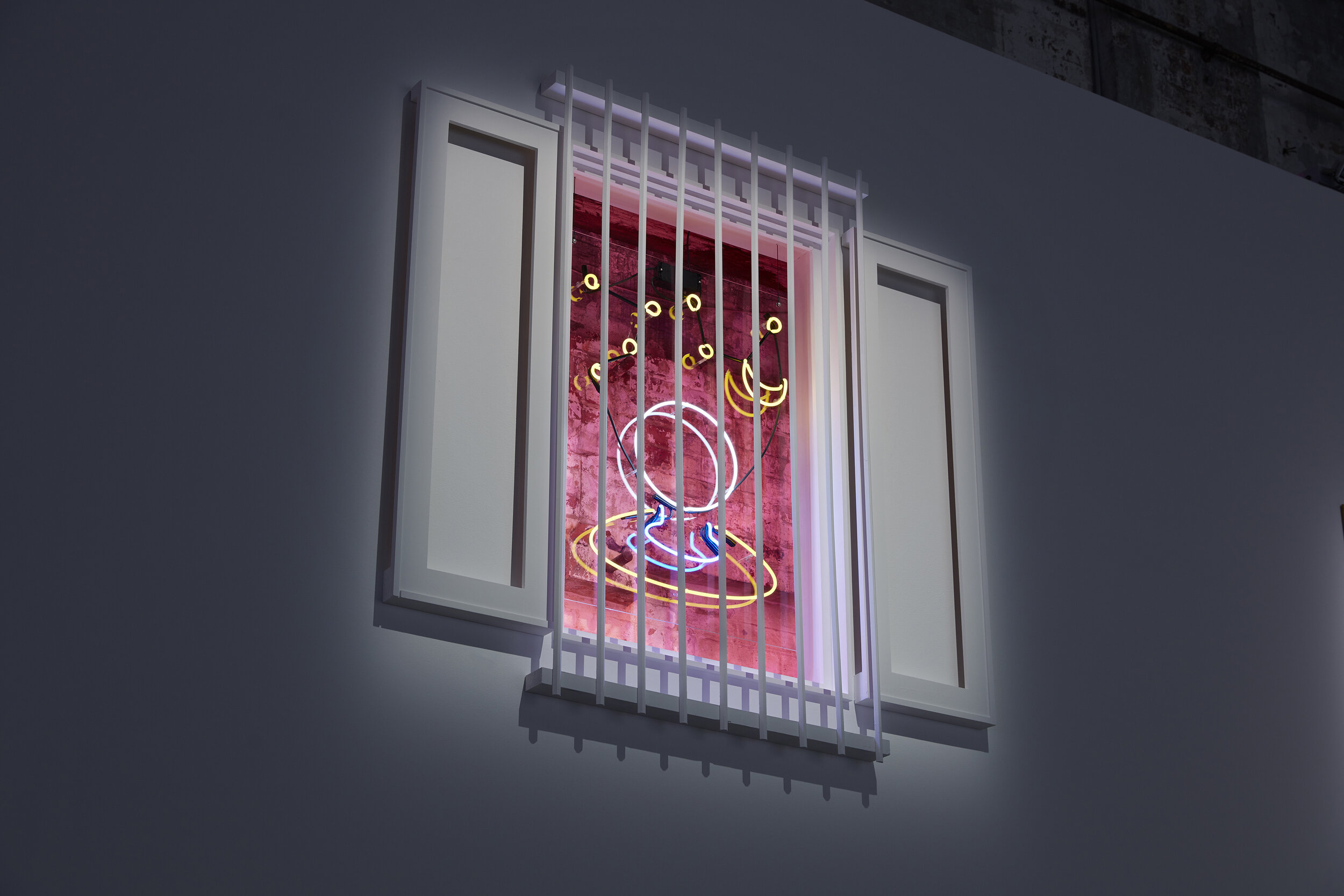





Psychic’s house 2021
neon and fluorescent lights, acrylic, wood, transformer
220 x 180 x 30 cm
Darren Sylvester’s photographic works depict scenes that are
meticulously constructed like film or theatre sets to emulate reality. His
pictures, many of them now quite iconic, are stylised portals to
moments between people that often manifest intimacy and alienation
in equal measure. Their titles are full of poetic yearning and existential
torment – Forgotten and alone but trying – a case in point. The artifice
of life under the seductive spell of late capitalism is amplified as
illusion. Within Sylvester’s hall of mirrors we are reflected as empty
vessels of false consciousness adorned by product placement,
eternally desiring desire itself.
– Daniel Mudie Cunningham

Crystal room 2021
neon and fluorescent lights, acrylic, wood, transformer
200 x 220 x 30 cm
‘Eyes Wide Shut’ was American filmmaker Stanley Kubrick’s final film.
Released in 1999, the filmmaker finalised his edit of the film and died
six days later. Both an erotic mystery and a psychological drama, the
screenplay draws from a 1929 Austrian novel, ‘Traumnovelle’ or
(‘Dream Story’) by Arthur Schnitzler, who describes the psycho-sexual
milieu and the cultural overturnings of early 20th Century Vienna. ‘Eyes
Wide Shut’ shares the same hypnotic sexuality and feverish, dream
like visions of Schnitzler’s novel, but transposed to a New York City
setting and a time contemporaneous to the making of the film, in the
1990’s. ‘Eyes Wide Shut’ was almost exclusively filmed in the UK,
requiring sets to be built at Pinewood Studios, located outside of
central London. The famously fastidious and perfectionist filmmaker
was obsessed with verisimilitude in this undertaking - Kubrick sent set
builders to Manhattan to measure widths of the footpaths, and to note
the location of newspaper vending machines, in his re-creation of
Greenwich Village. In this film, each encounter has the intensity of a
dream, one in which the moment is clear, but it’s hard to remember
where we have come from or where we are going next.

Burning candle 2021
neon and fluorescent lights, acrylic, wood, transformer
220 x 180 x 30 cm
The three neon windows of Sylvester’s work for The National 2021 are
similarly intricately calibrated- set architecturally into to the walls of the
gallery at Carriageworks and presented at full scale. Styled as New
York City shopfronts, the highly saturated colours of the neon symbols
act as an advertisement of a spiritual or psychic power available within.
Sylvester re-imagines the gallery as a street, a film set we can stroll
through, encountering the windows on our way. Less immersive than
Kubrick’s Greenwich Village, the works gesture towards a mise-en
scene, the green illumination of Burning candle is set within a carefully
constructed partial brick façade, while the glittering circles and moon
surrounding Crystal room are protected by security bars placed in
front, to either protect its power from outside dangers or perhaps
contain the energy within. The pulsating pink and blue Psychic’s house
neon is placed in front of a blind, cunningly framed by an architectural
construct that suggests a building in which the window might be
placed. The saturated glow of these works are an evocation, a
continual circling of desire that is without arrival or destination.

A gentle breeze of warm air travels through the windows as we walk
through the gallery, complicating our perception even further. We are
experiencing the architecture of the gallery in its totality, air flows
through the interior egress between the gallery wall and the
Carriageworks building and floats into the gallery through Sylvester’s
windows. Back of house workers appear briefly in Sylvester’s work,
framed behind the windows as they move through this interstitial
space. Teetering between reality and artifice, these works are dreams
within a dream, an emotional landscape to be collectively understood.
– Abigail Moncrieff, Curator of The National 2021:New Australian Art at Carriageworks